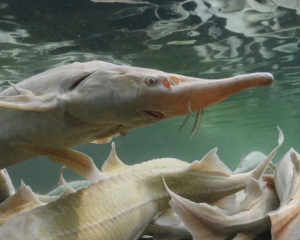After each fish is measured, sexed, and tagged, it is handed off to a group from the U.S. Fish & Wildlife Service, which collects eggs and milt from the female and male sturgeons, mixes them together with a turkey feather (it's soft enough to not damage the eggs as they are stirred), then transports the fertilized eggs back to the Warm Springs National Fish Hatchery in Georgia.
每條魚經(jīng)過(guò)測(cè)量、確認(rèn)性別、打上標(biāo)記后,會(huì)交給來(lái)自美國(guó)魚類和野生動(dòng)物管理局的團(tuán)隊(duì),該團(tuán)隊(duì)會(huì)從雌雄鱘魚身上采集魚卵和魚精液,使用火雞羽毛混合它們(火雞羽毛很柔軟,不會(huì)在攪拌魚卵和魚精子時(shí)破壞魚卵),然后將受精卵運(yùn)回喬治亞州的溫泉國(guó)家魚類孵化場(chǎng)。
About a month later, grow-out facilities like the Tennessee Aquarium, where Kuhajda works, pick up the fish and raise them in tanks, feeding them a diet of brine shrimp and bloodworms.
大約一個(gè)月后,人工養(yǎng)殖機(jī)構(gòu)會(huì)接收小魚,把他們放進(jìn)魚缸飼養(yǎng),并以豐年蝦和紅蟲喂食,庫(kù)哈伊達(dá)任職的田納西水族館就是其中一家人工養(yǎng)殖機(jī)構(gòu)。
After the fish have grown six inches long, they are released into rivers where sturgeons were long ago wiped out by overfishing, dredging, pollution, and dams.
小魚長(zhǎng)到6英寸之后會(huì)被放流到因過(guò)度捕撈、疏浚、污染、水壩而早已見不到鱘魚的河流中。
Since 2000, the aquarium and its partners have reintroduced more than 300,000 lake sturgeons into the Tennessee and Cumberland Rivers, hoping they will thrive in the stretches between dams.
自2000年起,田納西水族館和合作伙伴已將超過(guò)30萬(wàn)條湖鱘再引入田納西河與昆布蘭河,希望他們能在水壩之間的河段茁壯成長(zhǎng)。
The first females are just now reaching reproductive age -- somewhere north of 20 years in lake sturgeons -- though Kuhajda and his team have yet to see evidence that the reintroduced fish have successfully spawned and the larvae have survived the perilous float through the river systems' many stagnant reservoirs to transform into juvenile fish.
最早一批雌湖鱘如今剛達(dá)到生殖年齡,大致超過(guò)20歲,但庫(kù)哈伊達(dá)和他的團(tuán)隊(duì)尚未發(fā)現(xiàn)這些再引入的湖鱘成功產(chǎn)卵的證據(jù),也無(wú)證據(jù)顯示幼魚在河系中許多不流動(dòng)的水庫(kù)里歷經(jīng)危險(xiǎn)的漂流后幸存下來(lái),長(zhǎng)成為稚魚。
But restocked lake sturgeons have reproduced in river systems with longer free-flowing stretches in the Coosa River Basin in Georgia, and the researchers continue to hope.
不過(guò),在喬治亞州庫(kù)沙河流域,放流的湖鱘已在自由流動(dòng)區(qū)域較長(zhǎng)的河系里繁殖,研究人員也持續(xù)懷抱希望。

"When you start a sturgeon regeneration program, you are in it for a century," says Kuhajda, who joined the team in Wisconsin to collect fin clips to chart hatchery genetics. "It's a long-term investment."
庫(kù)哈伊達(dá)說(shuō):“只要你展開湖再生計(jì)劃,那就是一百年的事情。”他曾加入威斯康辛州的團(tuán)隊(duì),采集魚鰭檢體以詳細(xì)記錄孵化場(chǎng)的湖鱘基因資料。“這需要長(zhǎng)期投入。”
Before Stadig's team finishes its work, members count out 73 sturgeons to deliver to the Menominee tribe, whose reservation lies above Shawano Dam.
史塔蒂格的團(tuán)隊(duì)結(jié)束工作前,清點(diǎn)出73條準(zhǔn)備送去梅諾米尼部落的鱘魚,這個(gè)部落的保留區(qū)位于肖瓦諾水壩上方。
For thousands of years, the Menominee people gathered each spring for a feast and ceremony.
數(shù)千年來(lái),梅諾米尼人每年春天都聚在一起舉辦盛宴和儀式。
"We would wait for the sturgeon to come after the long winter months," says David Grignon, the tribe's historic preservation officer.
部落的歷史保存官員大衛(wèi)·格里尼翁說(shuō):“我們會(huì)在漫長(zhǎng)的冬季過(guò)后等待鱘魚前來(lái)。”
When the dam was built more than 130 years ago, the sturgeon migration was blocked and the ceremony ceased.
自從超過(guò)130年前蓋了肖瓦諾水壩后,鱘魚遷徙就遭到阻斷,而這場(chǎng)儀式也隨之停止。
A century later, thanks to the state's recovery efforts, Wisconsin officials in collaboration with the tribe began hauling the fish around the dams,
100年后,拜威斯康辛州的再生工作所賜,州政府官員與梅諾米尼部落合作,開始將鱘魚繞過(guò)水壩送去,
"They transport them up in big trucks and tanks" each spring, says Grignon -- and the tribe revived its ceremony that features dancers who mimic the movement of the sturgeons up the river.
格里尼翁說(shuō),每年春天“他們都用大卡車和魚缸把鱘魚運(yùn)送到上游去。”而部落也恢復(fù)舉行儀式,儀式中,舞者會(huì)模彷鱘魚在河中逆流而上的動(dòng)作。
Tribal officials are also working to install a passage in one dam to restore the natural migration of sturgeons to the reservation.
部落官員也正努力在一處水壩設(shè)置通道,以便恢復(fù)鱘魚游向保留區(qū)的自然遷徙活動(dòng)。
But for now, sturgeon generals like Stadig must serve as midwives too, trucking the fish across unbreachable human boundaries.
不過(guò),目前史塔蒂格等鱘魚總長(zhǎng)還是得扮演助產(chǎn)士的角色,用卡車幫助鱘魚跨越他們無(wú)法通過(guò)的人為障礙。












